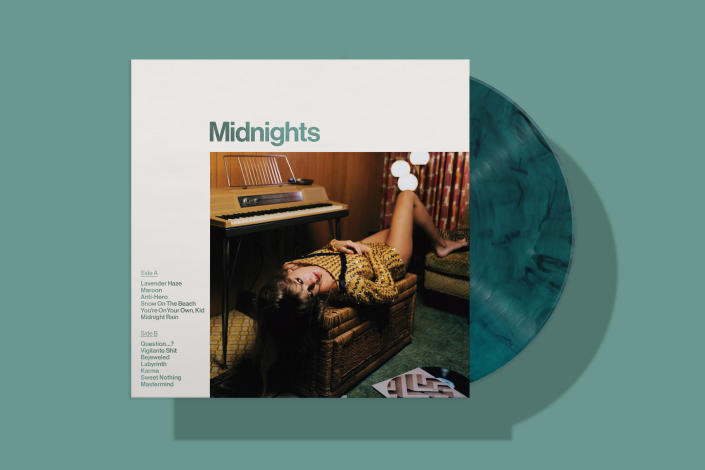
Taylor Swift’s new album, “Midnights,” Blue Edition Credit –
With the release of her new album Midnights, Taylor Swift is poised to reclaim her weekly record-sales title from Harry Styles, who eclipsed her previous album’s sales back in June. Records, in this case, refer to vinyl, the kind your (grand) parents used to listen to, and now, apparently, your tween-age daughters too.
Swift is likely to achieve her latest feat not just because of her immense popularity, but a clever marketing ploy that presents her albums as items to be collected as much as listened to: fans can choose among four vinyl editions of the same $29.99 album, each with different cover art. Superfans can assemble all four into functional wall art with the addition of a clock kit that sells for $49.
But vinyl LPs are made from un-recyclable plastic in a process that produces approximately 0.5 kg of CO2 per album—the equivalent of driving two miles in a gasoline powered car. In the overall scheme of things, it’s not much, but buying four copies of one album in the pursuit of fan art stretches the standards of environmental responsibility. What ever happened to album art that could be unfolded into a poster?
Vinyl records have been outselling CDs since 2021, which, coincidently, was when Swift’s previous album, Red, broke the record for first week vinyl sales. Not that CDs are much better when it comes to their plastic and carbon footprint: when digital downloads became the dominant form of music consumption in the US, the industry went from using 134 million pounds of plastic per year in 2000 (peak CD), to 17 million in 2016.

So streaming is better, right? It depends. Even though streaming formats are plastic-free it doesn’t mean they don’t have an environmental impact. Electronic music files are stored on servers that run on a continuous stream of energy. Retrieving the files and playing them via networks and routers also uses up energy. Researchers from the department of environmental sustainability at the UK’s Keele University estimate that streaming an album for just 17 hours would produce the same amount of carbon emissions as creating a vinyl record. For CDs, it would take five hours of running time. So die-hard fans that plan on listening to Midnights on repeat for the next few months would do better, environmentally speaking, buying the vinyl.
For the casual listener, streaming is more sustainable, says Kyle Devine, a professor of musicology at the University of Oslo’s School of Environmental Humanities, and the author of Decomposed: the Political Ecology of Music. “One to one, streaming is a much more efficient use of resources,” he says. For him, the greater concern is the scale and the everywhere, all the time culture of streaming. Some 487 million people worldwide were subscribed to music streaming platforms at the start of 2021, creating a significant carbon footprint. “If people started listening to records as much as they do streaming, vinyl would be much more carbon intensive,” says Devine.
Or, if like Swift, musicians keep turning their records into collectables instead of albums to be played.
There is an alternative. Several start-ups, including a British organization called Evolution Music, have started producing plastic-free vinyl using plant-based materials. Evolution Music’s first compostable 12-inch, released last month, featured tracks from REM’s Michael Stipe and the UK’s Beatie Wolfe. The music industry is starting to pay attention to sustainability, says Devine. Swift should be too. “Especially with her fan base, a younger generation that is pretty thirsty for change when it comes to climate issues.”
It may not be too late for Swift to go green, he says. “There isn’t anything preventing her from switching to a bioplastic format when this production run runs out.” Now that would be an album worth collecting, wall art or not.
